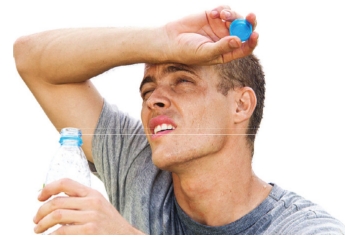THE HEAT IS ON

It’s August. And if you were not already aware, it is hot.
As temperatures rise, the risk of heat illness for those participating in outdoor activities rises with them. Children, individuals with low fitness levels and those who have suffered from a previous heat illness are more susceptible to falling victim of the heat.
Dehydration occurs when the fluids lost by our body while sweating are not replaced. Even the mildest dehydration can cause a decrease in performance and increase the risk of further heat illness. Signs and symptoms of dehydration may include: dry mouth, increased thirst, headache, dizziness and fatigue. If an individual is dehydrated during activity, they should stop activity and drink water and/or sports drinks to replace the fluids they lost through sweat. Moving to a shaded area or inside an air-conditioned building will help combat the effects of dehydration. If fluids are not replaced and activity continues while dehydrated, more severe forms of heat illness can occur.
Muscle Cramps Muscle cramps are considered to be a mild form of heat illness. If you have ever experienced muscle cramping, you know that the pain associated with cramp can be described as anything but mild. Muscle cramps can be caused by a loss of electrolytes. Treatment for one of these persistent involuntary muscle contractions includes gentle stretching and/or massage of the affected area. The lost electrolytes should be replaced with a sports drink or an electrolyte supplement. Once the cramping has subsided and the individual feels better, they may resume activity but should be aware that cramping may occur again.
Heat Exhaustion Heat exhaustion occurs when the body’s core temperature is elevated up to 104 degrees. An individual that is experiencing heat exhaustion will sweat profusely and have pale skin. They may lose coordination, become dizzy and/or faint. Other signs and symptoms may include a headache, becoming nauseous and/or vomiting. The treatment for an individual suffering from heat exhaustion includes moving them to a cool environment (preferably into an air-conditioned space), removing equipment and extra articles of clothing. Efforts should be made to cool the individual down with cold towels, ice bags or cold water immersion. IV fluids may be necessary to assist in recovering from heat exhaustion. Once the core temperature is returned to normal and the individual feels better, they should wait a few days to gradually return to activity.
Heat Stroke The most severe form of heat illness is heat stroke, which can be life-threatening. Heat stroke is characterized by a core temperature of 105 degrees or greater. The signs and symptoms of heat stroke are similar to those of heat exhaustion with the exception of the profuse sweating associated with heat exhaustion. Lack of sweat and is an indication that someone has fallen victim to heat stroke. Efforts should be focused on the immediate cooling of the individual. Decreasing the core temperature within the first 10 to 30 minutes is crucial to survival. Remove all equipment and excess clothing and place the person in cold water. Cold water immersion is considered to be the “gold standard” for the treatment of heat stroke. Continue adding ice to the water and “stir” the water to constantly move the water around the individual. If immersion is not possible, move the individual to a cool environment and place cold, wet towels all over the individual’s body, replacing them often. Once the cooling process has begun, call 911. Because the cooling of the individual is so vital, you should always: cool first, call second. Anyone who has heat stroke will need further medical attention from a physician. They should not be allowed to participate in any activity until they receive permission from their physician.
Fortunately, all heat illness is preventable.
The best method of prevention is acclimatization. Gradually introducing activity in extreme heat allows for the body to adapt to the environment. Begin with shorter, less intense activities with long breaks. As you add volume and intensity to your activity, breaks may be shorter but should also be more frequent.
Check the weather forecasts and choose a cooler part of the day to participate in your activity. Minimizing the amount of equipment worn during activity can also help you acclimatize to the heat. For reference, the Louisiana High School Athletic Association mandates that football teams cannot begin practicing in full equipment until 10 days after the first practice of the year. Make sure you are properly hydrating and eating for the amount of activity you are participating in. Make sure that you are consuming enough fluids and calories throughout your day in preparation for your activity.
You can still enjoy outdoor activities in the blazing Louisiana heat. But it is important to be smart, plan ahead and know how to identify and treat different types of heat illness. Stay cool!
Lance Champagne is an athletic trainer with the Willis- Knighton Sports Medicine Department and is currently serving at LSU Shreveport.
